Raiden Network Token: The Ethereum off-chain Scaling Solution
The Raiden Network Token (RDN) has been getting a lot of attention recently given the focus on Etheruem Scaling.
RDN is the native token of the Raiden Network which is developing a protocol to help Ethereum overcome their scalability issues. It is an off-chain solution that aims to deliver near-instant and low-fee payments irrespective of the current state of the Ethereum network.
However, is the network still needed and does RDN have a long-term use case?
In this Raiden Network review, I will give you what you need to know about the project. I will also look into the long term RDN token use cases and large-scale adoption potential.
Ethereum's Scaling Problem
Micropayments are an essential feature for any cryptocurrency looking to disrupt the traditional financial system. In order for a cryptocurrency to achieve mainstream adoption, users must be able to pay for simple items like a cup of coffee or a bus ticket with ease.
Currently, Bitcoin is only capable of processing 7 transactions per second (tps), Ethereum is slight faster with 10-15 tps, yet is still a far cry from traditional payment solutions like the Visa credit card, which achieves 45,000 tps.
The Ethereum blockchain is working to build scaling solutions that will prevent payment confirmation backlogs during network traffic surges.
Raiden Network Overview
One of these is the Raiden Network, which is a blockchain protocol (and ‘layer 2’ scaling solution) that aims to provide “fast, cheap and scalable token transfers for Ethereum”.
The protocol exists as a complimentary scaling solution to the Ethereum blockchain, focused on tackling the problem of costly fees and long confirmation times that hinder ERC20 compliant tokens from being utilized as an efficient medium of exchange.
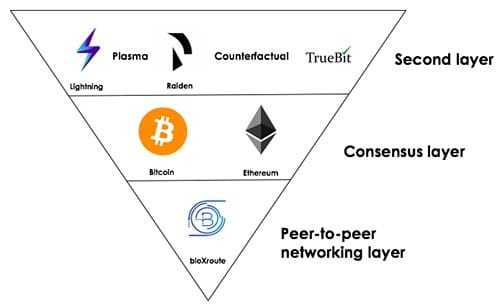
The Raiden network bears some similarities to Bitcoins lightening network, but is designed with additional security measures that make it more adequate for processing payments.
The Raiden Network provides multiple benefits:
- Faster transfer confirmations (less than 1 second, compared to many seconds or even minutes on the Ethereum blockchain)
- Scalability that enables mass adoption for Ethereum
- Increased privacy due to transactions occurring ‘off chain’
- Low fee transactions
- Micropayment capabilities
- Designed specifically for ERC-20 tokens like EOS (EOS), Tron (TRX), Icon (ICX), Binance Coin (BNB) and more
How Raiden Works
Raiden provides a network of ‘off-chain’ payment channels that enable participants to send tokens to each other without needing global consensus or involving the blockchain for every transfer.
- When users send tokens to each other through private messages, they are opening up a single ‘off chain’ payment channel in which their tokens can be transferred back and forth between participants. This is achieved using ‘balance proofs’, which are digitally signed and hash-locked transfers.
- Security is maintained because the network requires participants to deposit an initial ‘down payment’ on-chain in order to open up the off-chain payment channel. This deposit establishes collateral for the off-chain transactions
- The off chain payment channel established will allow for an unlimited number of transfers between the 2 participants, as long as the net sum of their transfers does not exceed the collateral ‘down payment’ that was initially deposited
- When the payment channel is ready to be closed, all off-chain transactions will be bundled up and sent back to the main Blockchain, where they can be processed as one single on-chain transaction
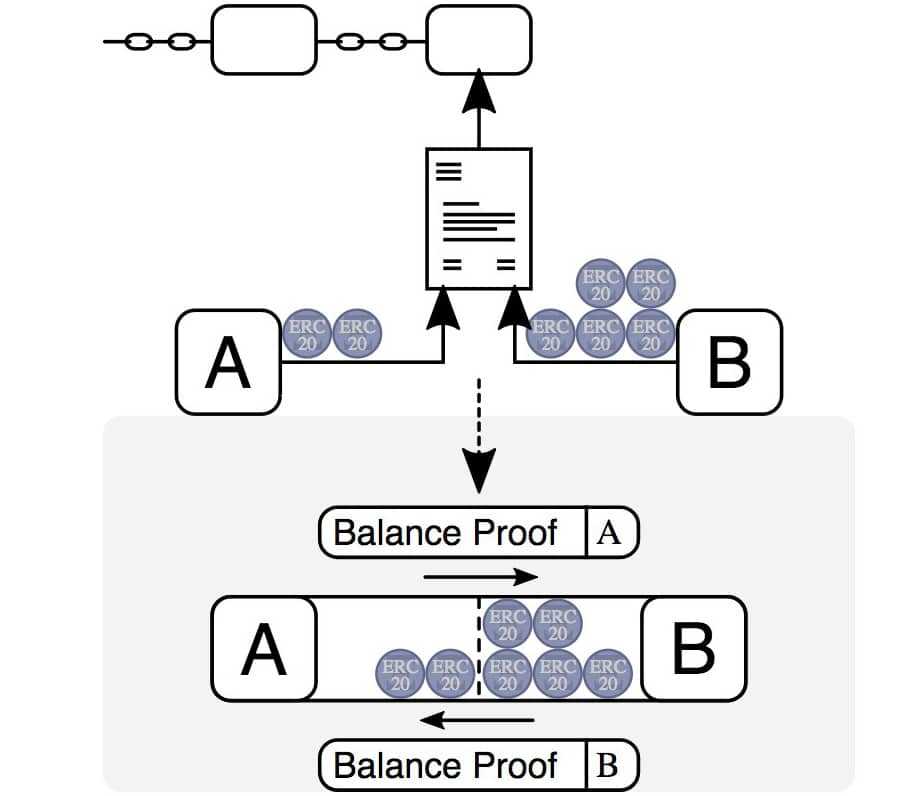
- Off-chain payment channels are always setup between just 2 participants. However, the protocol has developed an interconnected system whereby multiple off chain payment channels can become ‘interlocked’ once a common participant bridges the connection between 2 other participants:
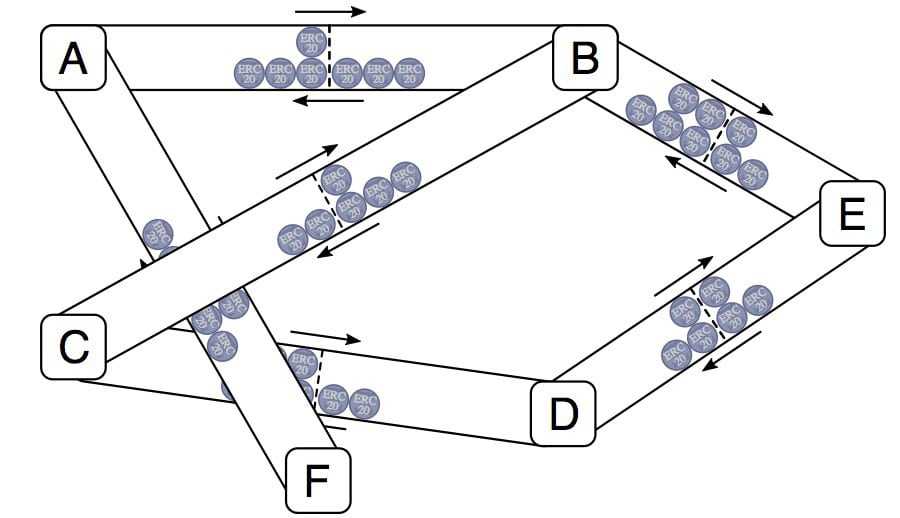
As you can see from the above, participants are all connected through a web of payment channels. This system for routing and interlocking channel transfers is called the Raiden Network.
- Off-chain payment channels do not require any fees. In fact, users are able to monetize their free payments channels by offering them to participants on the main blockchain network for a smaller fee than what is charged for transacting on-chain
- Raiden Network Tokens (RDN) are generated to create micropayment channels and perform payments over these channels through µRaiden, which is a payment channel framework for fast & free off-chain ERC20 token transfers
RDN Token
Unlike many other early stage cryptocurrency projects, the Raiden Network did not hold a traditional Initial Coin Offering (ICO) for their tokens. They sold part of their token supply through an Auction process.
This was done in order to prevent an inequitable distribution of tokens. Using an auction process prevented whales from quickly buying up all of the offering supply.

There was a total fixed supply of 100m RDN tokens that were generated. 50% of these were sold in the auction. The remaining tokens were split between the external development fund (16%) and brainbot labs (34%). You can read more about this issuance in this post.
As mentioned, the RDN tokens are the utility token that will be used in these micropayment channels. Hence, the fundamental value of these tokens will be tied to the amount of network activity that takes place on the Raiden Network.
In terms of RDN price performance, it has been quite a rocky ride...
Not long after the issuance, RDN hit the exchanges and followed the rest of the market to an all time high of $7.5 in January of 2018. However, since then the market entered bear market territory and RDN has retraced to current levels.
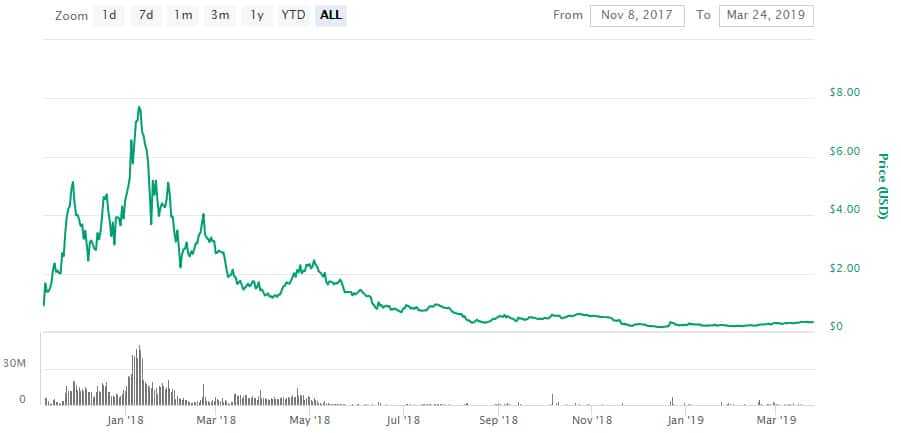
RDN is a relatively liquid token and can be bought on a number of exchanges. Most of the volume takes place on LAToken and the Binance Exchange. However, they are listed on a number of other exchanges including BitHump and Huobi global.
Once you have your RDN token, you will need to store them in a compatible wallet. Given that this is an ERC20 wallet, there are a plethora of wallets and storage options that you can consider. Your best bets are probably to use either MyEtherwallet, MyCrypto or Metamask.
Raiden Network Team
The Raiden Network is being developed by a blockchain software company based in Germany called the Brainbot Technologies AG. This was founded in 2000 by Heiko Hees, an Ethereum core developer. This means that his skills are well aligned to the development of a scaling solution.
Brainbot has grown considerably over the years and they have offices in Berlin, Copenhagen and Mainz. They have also been on a hiring spree as they try to increase their developer talent. According to this post they hired 15 new members to their team in 2018.
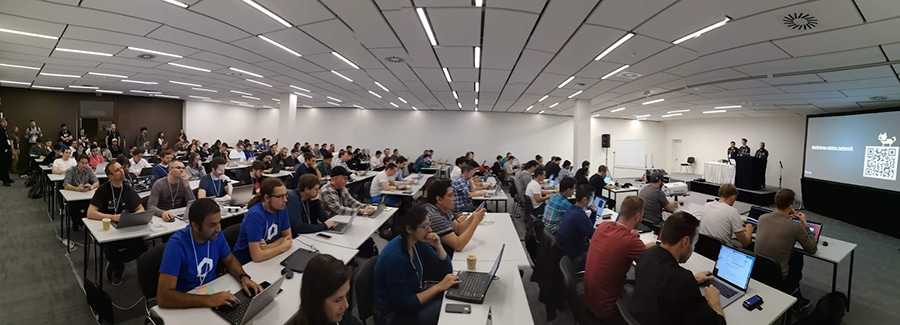
They have also been very active in the Ethereum community and have attended numerous ETH Devcons and smaller local meetups. You can follow the latest updates and announcements from Brainbot on their Medium blog.
Development & Roadmap
Determining exactly how much work is being done on a project can be hard. However, one of the best ways to approximate this is by taking a look at their GitHub activity. Code commits to a public repository can give a great deal of insight.
I decided to take a closer look at the Raiden Network Github to get a better sense of how much code is being pushed. There are 16 different repositories but the most important of these is their Raiden core repo. Below is the commit activity:
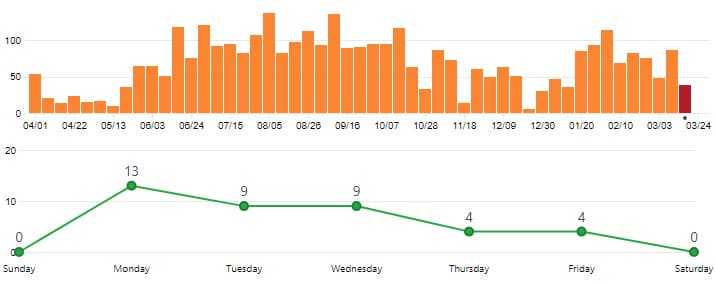
As you can see from the activity, there is extensive work being done on the protocol. In fact, if one was to compare this activity to those of other projects, it is one of the most active. They are ranked at number 12 in total commits when measured against others.
This is very encouraging to see and shows that despite the crypto bear market, the developers are still beavering away at a frenetic pace.
This intense development work is probably because of the ambitious plans that they have laid out in their project Roadmap. Below are some of the updates that they would like to include:
- Channel Withdraw
- Atomic Token Swaps
- Cooperative Settle
- Fee Model for Channel Balancing
- Raiden Service Bundle
- Pathfinding Services
- Monitoring Services
They have not given any defined timelines for the roll-out of these updates. However, they have actively been meeting previous development targets so that is encouraging. You can get more in-depth updates from the project from their medium blog.
Other Ethereum 2.0 Solutions
Raiden Network represents one of the newest offerings that are part of Ethereum’s 2nd major development phase (also known as ethereum 2.0).
Of course, they are not the only project our solution that falls into this category. There are a number of other upgrades and protocols that are being developed in order to address scaling:
- Proof-of-Stake (PoS): Beacon and Casper are the 2 PoS solutions that aim to improve how new Ethereum coins are mined and how transactions are validated. In PoS, there is no mining which means there is no block reward, the block creators which are called Forgers (instead of Miners in PoW) are being incentives only by transaction fees. The Forgers of the next block is being elected through a random procedure according to the Forger stake (amounts of coins he is staking) and age.
- Plasma: This is an extra layer that sits on top of the network to handle massive amounts of transactions. It is basically Ethereum’s version of Bitcoins Lightening Network.
- eWASM: eWASM allows code to execute faster by expanding coding options and capabilities for the Ethereum Virtual Machine.
- Sharding: This is the process by which the entire state of the network is split into a bunch of partitions called shards that contain their own independent piece of state and transaction history. Sharding addresses issues of scalability and transaction speed and stops one app from slowing down the network.
Conclusion
The Raiden team believes that cryptocurrencies need to achieve up to a million transactions per second in order to be adopted on a mass scale.
As ambitious as this number seems, the sophistication of the Raiden networks design is such that it could one day help the Ethereum blockchain achieve such a massive transaction output.
The project is being driven by a host of competent developers in the Ethereum community. Moreover, they have been incredibly active working on the protocol as can be evidenced from their GitHub activity.
While the token performance has been disappointing over the past year, this is because of the general market conditions and not project specific factors. As the team rolls out more updates in line with their roadmap, it could provide positive sentiment.
Of course, I would encourage you to Do Your Own Research but as an Ethereum scaling solution, Raiden should feature prominently in that DYOR list.
Disclaimer: These are the writer’s opinions and should not be considered investment advice. Readers should do their own research.
